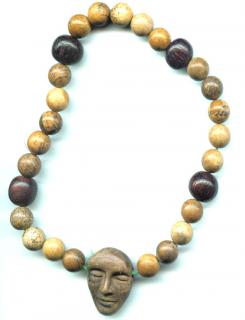Handout 1: A Unitarian Universalist Prayer Bead Practice

Tapestry is Sunsetting
The UUA is no longer updating Tapestry of Faith programs.
What follows is not intended to dictate how to pray, but rather is a suggested structure onto which you can hang your own developing prayer practice. It draws upon the prayer practices of a number of religious traditions and seeks to put together a pattern of prayer that you can tailor to your own needs and understandings. This practice uses the image of a journey, one form of prayer moving into the next.
Preparation: The first, largest bead provides a way into this prayer journey. While touching it, you might gently breathe in and out a few times, sing a favorite hymn, or recite a passage of scripture that centers you and creates a space within for the prayer that is to follow.
Entering In: With the four small beads at the beginning of the prayer circle, you enter into this “journey” of prayer. With each bead you might recite the verses of a Buddhist gatha, such as:
Breathing in, I relax body and mind.
Breathing out, I smile.
Dwelling in the present moment,
I realize this is the only moment.
You might call on the spirits of Earth, Air, Fire, and Water. Or you can create your own entering prayer. I say:
Open my eyes, that I might see your face in everyone I encounter this day, myself included.
Open my ears, that I might hear your voice in whatever forms it takes.
Open my hands, that I might freely give whatever is mine to share.
Open my heart, that I might live and love more fully in you.
Take the time here to be fully intentional about this time.
Naming: The first medium-size bead is for naming the sacred and the holy as you encounter it. In traditional prayer terminology, this is praise and thanksgiving. You can think of it as naming the places in your life where miracles abound, a chance to “count your blessings,” or a way of beginning your prayer centered in the awareness of the ways in which the holy is happening in your life.
The Small Beads: The three sets of five small beads between the medium-size beads are for “breath prayer.” Many of the world’s religious traditions encourage a short, repetitive prayer tied to the breath. You say one line on the in-breath and a second on the out-breath. You can use two lines from tradition or scripture—the classic from the Christian tradition is “Jesus Christ / have mercy on me”—or you can create your own. Once you settle on a two-part phrase, keep saying the same thing. Part of the power of a breath prayer is its repetition. Live with it long enough for it to become a part of you.
Knowing: The second medium-size bead is for giving voice to the broken, wounded, worried places in your soul. (Traditionally, this is called a prayer of confession.) It is the chance to take a “fearless moral inventory” and to give voice to what lurks in the shadow. Prayer calls on us to be authentic, whole people, and knowing where we are weak and wounded is essential.
Listening: The third medium-size bead is for listening to “the voice of quiet stillness” within. This is a chance to sit in the Mystery, gently breathing. (Depending on the tradition, this is called meditation or contemplation.) Far too often, people think of prayer as “talking to the sacred,” forgetting that in any good conversation we must make room to listen as well as speak.
Loving: If your prayer journey is just for your own sake, then it is ultimately hollow. The fourth and last medium-size bead provides a place to bring the concerns of others—family, friends, communities, the world—into your prayer. These prayers of intercession, as they are traditionally called, are a chance to encourage your prayer to move outward. Call to mind people and situations you know who are in need, or sit quietly and see who (or what) comes to mind.
Closing: Whatever you said to enter into your prayer time, repeat with the four beads at the end of the circle.
Putting It All Together: You can take the journey of this prayer practice all at one time (expect to spend at least 30 minutes), or you can spread it out during the day (for example, Naming after breakfast, Knowing at lunch, Listening before dinner, and Loving before bed). Some people carry their beads with them everywhere, like “worry beads,” and find that simply touching them—while in line at the bank, or when waiting for a friend—brings them into a prayerful place.
This practice is expanded—and a Unitarian Universalist perspective on prayer is more fully explored—in Erik Walker Wikstrom’s Simply Pray: A Modern Spiritual Practice to Deepen Your Life (Skinner House Books, 2005).
Simply PrayA Modern Spiritual Practice to Deepen Your Life
By Erik Walker Wikstrom
